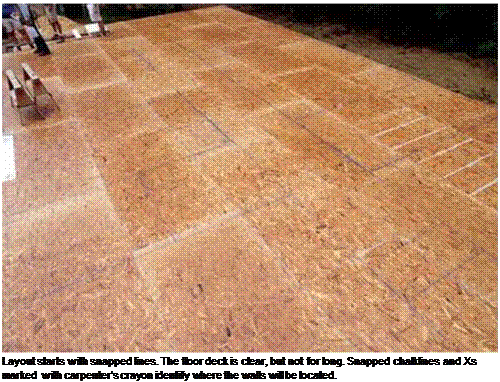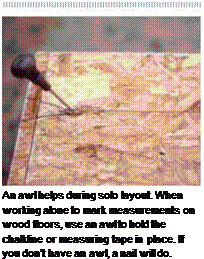Mark exterior walls first
square corners or nonparallel walls. The lines you snap define the inside edge of the exterior walls. For 2×4 walls, measure 3V2 in. in from the deck edge (slightly more or less if you need to get the walls square and parallel). If the walls will be framed with 2 x6s, use a 51/2-in. measurement. Instead of measuring this distance, you can simply lay a scrap 2x 4 (or 2x 6) on the deck and mark against its inside edge.


![]() Mark all the exterior corners to establish the layout marks for snapping the exterior wall lines around the perimeter of the floor (or slab).
Mark all the exterior corners to establish the layout marks for snapping the exterior wall lines around the perimeter of the floor (or slab).
When you’ve marked all the corners, snap lines around the perimeter. If you’re working on a concrete slab, you may want to move all these lines in an extra У2 in. so that the wall sheathing can be nailed onto the framed wall flush with the concrete. At this point, pay no attention to the openings for doors and windows—just snap the wall lines right through the openings.
Begin laying out the interior walls by measuring from the exterior walls. For example, the illustration on p. 79 calls for a distance of 12 ft. 7 in. from the outside corner of the house to the center of a partition wall. Add or subtract 13/4 in. from that distance to snap the layout line for the partition wall. Remember to note how measurements are given on the plans. Lay out
long interior walls (such as hallways) first, then do the short walls (such as closets). There is no need to mark the door and wall openings.
For hallways, the minimum width is 37 in. in the rough, which yields a finished width of 36 in. (accounting for /Tin. drywall installed on each side). I sometimes frame hallways 40 in. wide in the rough to create easier passage for a wheelchair (a standard wheelchair is 26 in. wide).
Pay particular attention to squaring bathrooms and kitchens, which makes it easier to set cabinets and install vinyl flooring. When framing on a slab, plumbing lines will have been set in the concrete. If a pipe was placed slightly outside where a wall should be, it’s better to move the wall rather than the pipe. If the pipe misses the wall by a lot, you’ll need to involve a plumber.
Although a standard bathtub is 60 in. long, I snap wall lines with a 601/8-in. space for the tub, which makes installation easier for the plumber. I also lay out the bathroom’s plumbing wall with a 2×6 wall instead of a 2×4; a wider wall makes it much easier to fit all the bathroom pipes inside.






Leave a reply